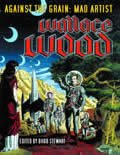Friday, May 20, 2011
Popeye: The Great Comic Book Tales by Bud Sagendorf
Craig Yoe, editor and designer. Introduction by Jerry Beck. Yoe Books/IDW, $29.99 (176p) ISBN 978-1-60010-747-4
In the early 1930s, Bud Sagendorf’s sister worked in a Santa Monica art supply store where Popeye creator E.C. Segar bought his art materials. After she introduced the two, the 17-year-old Sagendorf soon had a job as Segar’s assistant on the Thimble Theatre comic strip.
For seven years, Sagendorf learned cartooning from the master. When Segar died in 1938, King Features inexplicably decided not to turn the strip over to Sagendorf. Instead, he was given a job laboring in the King Features bullpen.
In 1948, he began as the writer-artist of Dell’s Popeye comic books (a series he continued until 1962), and he took over the Thimble Theatre strip in 1959.
Craig Yoe notes that Sagendorf, in chalk talks and interviews, most often referred to his newspaper strip: “He rarely talked of his comic book work. Comic strips were Big Time. They had prestige and sometimes even financial reward. Comic books were low-rent, thought of as ‘only’ a kid’s medium, even greatly looked down on in some circles. But the comic books were a great artistic medium for Bud.”
Yoe offers nine color stories that were published between 1948 and 1957 with “a plethora of Popeye twister-sock punches, punchy art, and punch lines.” Yes, plenty of punches are thrown, including Popeye’s rotating “twisker-sock”. “Interplanetary Battle” (1952) pits Popeye against Jetoe, a shape-shifting Martian. “Shrink Weed” (1953), a wild adventure in which Popeye and Swee’pea are miniaturized and used for fish bait, was written a year after Mary Norton’s The Borrowers was first published, and it reads like a satire of Norton’s tiny family. In “The Happy Little Island” (1954) Popeye outwits the underground Dismal Demons who have caused happy islanders to become sad islanders. It’s evident that Sagendorf loved to create imaginative premises and see how Popeye, Wimpy, Olive Oyl and others would deal with the strange situations. It’s fun to go along on these fanciful flights, flowing easily from panel to panel.
The color restoration is effective except for a few conspicuous spots. Some other minor quibbles: An incorrect page number is given in a comparison of b/w original art with the printed color version. Captions in black type on a dark blue background are difficult to read even under a strong light.
As he has done with his other books, Yoe presents a fascinating selection of photos, memorabilia and relevant images, such as Sagendorf-inspired Popeye paintings by Roy Lichtenstein and Andy Warhol. There’s a 1938 Sagendorf cartoon from Popular Photography, an autographed flier from the 1977 installation of the Popeye statue in Segar’s birthplace, Chester, Illinois, and an “extremely rare” 16-page comic book Sagendorf drew for the Red Cross in 1946.
WWII Popeye postcards have spaces for servicemen to fill in their names and mail home. Outstanding is Sagendorf’s contribution to the 1956 Famous Artists Cartoon Course, pages showing basic drawing of objects and exteriors simplified in clean cartoon lines. Amid such delights are the humorous design devices one now expects from Yoe Studios: Page numbers throughout the book cleverly cascade from tiny cans of spinach (see page 43 above), and the front cover curves credits around a giant can of spinach.
Sagendorf’s life journey took him from Wenatchee, Washington, to Santa Monica to Manhattan to rural Connecticut to Florida. Bill Pearson, who wrote Popeye comic books after Sagendorf retired, recalled meeting him in Connecticut: “What a genius!... Sagendorf’s comic books were classics, completely his own, with a fascinating unique environment for the cast. He would fashion long, convoluted plots, with Popeye lost in strange places for pages, ruminating about his fate and the fate of the universe. Brilliant stream-of-consciousness tales, with plenty of action and suspense, and clever, silly cartooning that carried it all beautifully.”
Reading just a single story confirms that Pearson’s description is apt. Oddly, the National Cartoonists Society never gave Sagendorf any kind of award. They could make up for that shameful oversight by giving an award to Craig Yoe for delivering this attractive, eye-popping Popeye package.
Bud Sagendorf, at age 23, drawing the
Popular Photography cartoon seen above.
Popular Photography cartoon seen above.
Labels: bill pearson, craig yoe, popeye, sagendorf, segar






